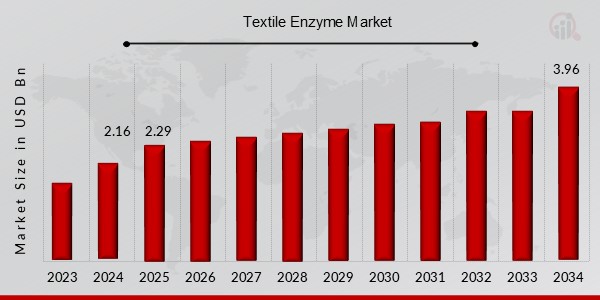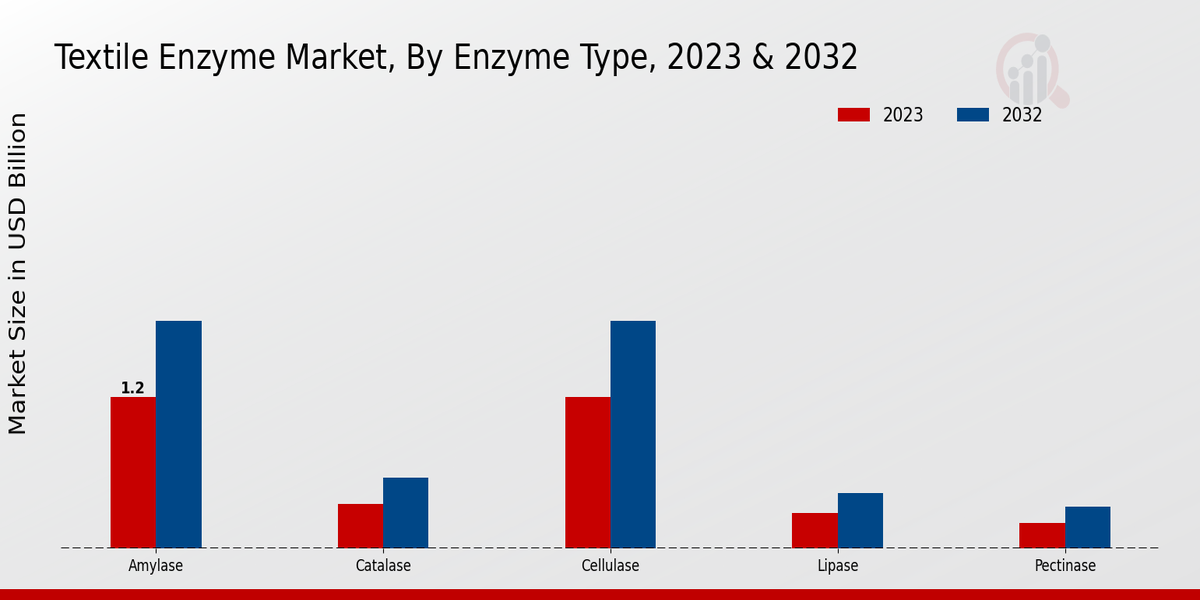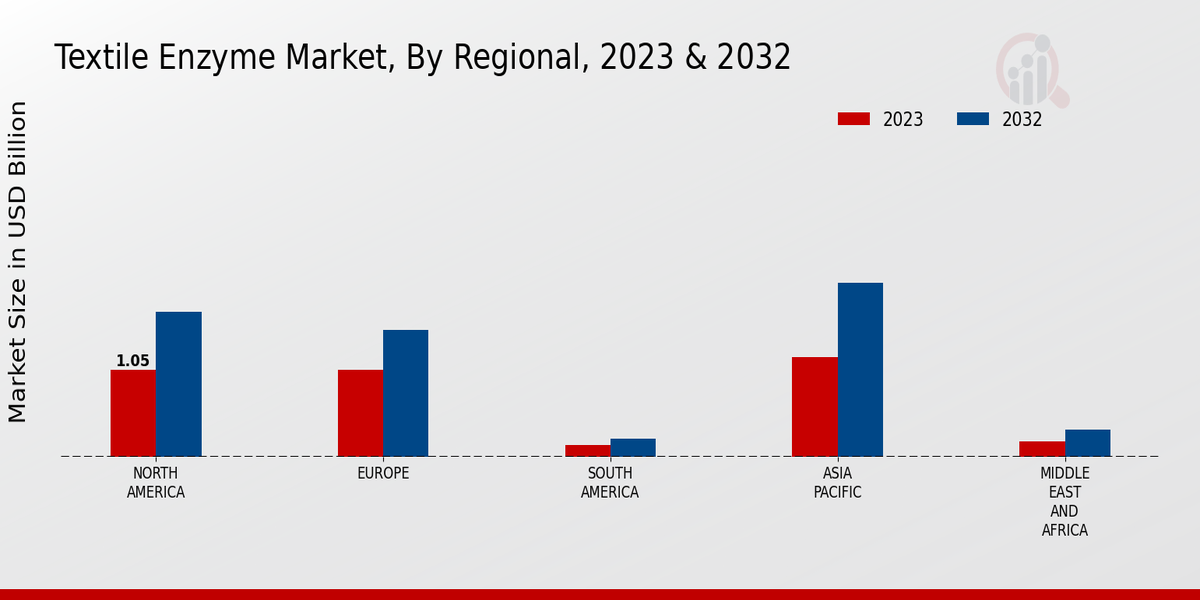Global Textile Enzyme Market Overview
The Textile Enzyme Market Size was estimated at 2.16 (USD Billion) in 2024. The Textile Enzyme Industry is expected to grow from 2.29 (USD Billion) in 2025 to 3.96 (USD Billion) by 2034. The Textile Enzyme Market CAGR (growth rate) is expected to be around 6.3% during the forecast period (2025 - 2034).
Key Textile Enzyme Market Trends Highlighted
The Textile Enzyme Market is experiencing significant growth, driven by increasing demand for sustainable and high-performance textiles. Key market drivers include the rising popularity of bio-based and eco-friendly enzymes, the need for improved textile quality and functionality, and the growing adoption of enzymes in various textile manufacturing processes.Emerging opportunities exist in the exploration of novel enzymes with enhanced catalytic activity and substrate specificity. Additionally, the development of tailored enzymes for specific textile applications presents lucrative growth avenues. Recent trends in the market include the integration of enzymes into automated textile production systems and the emergence of enzyme-based solutions for textile waste reduction and recycling.By leveraging these market dynamics, industry players can capitalize on opportunities by investing in research and development of innovative enzymes, exploring partnerships with textile manufacturers, and expanding into emerging markets.

Source: Primary Research, Secondary Research, MRFR Database and Analyst Review
Textile Enzyme Market Drivers
Growing Demand for Sustainable Textiles
The rising consumer awareness about environmental sustainability is driving the demand for eco-friendly textiles. Textile enzymes play a crucial role in reducing the environmental impact of textile production by enabling efficient and eco-friendly processes. They offer solutions for bio-preparation, bio-stoning, bio-bleaching, and bio-dyeing, which significantly reduce water and energy consumption, chemical usage, and wastewater generation. The increasing adoption of sustainable practices by textile manufacturers and the growing popularity of eco-friendly fashion are propelling the growth of the textile enzyme market.
Advancements in Biotechnology
Technological advancements in biotechnology are leading to the development of innovative textile enzymes with enhanced performance and specificity. Research and development efforts are focused on creating enzymes that can operate under extreme conditions, such as high temperatures and pH levels, and can effectively target specific substrates. These advancements are expanding the applications of textile enzymes and improving their efficiency, which is driving market growth.
Expansion of Textile Production in Emerging Economies
The growing textile industry in emerging economies, particularly in Asia-Pacific and Latin America, is a major driver of the textile enzyme market. These regions are experiencing a surge in textile production due to favorable government policies, low labor costs, and increasing domestic demand. The expansion of textile manufacturing facilities in these regions is creating a high demand for textile enzymes, as they are essential for optimizing production processes and ensuring the quality of textiles.
Textile Enzyme Market Segment Insights:
Textile Enzyme Market Enzyme Type Insights
The Enzyme Type segment plays a crucial role in the Textile Enzyme Market, with each enzyme type catering to specific textile processing needs. Amylase enzymes, with a global market revenue forecasted to reach USD 1.2 billion by 2024, are commonly used in desizing, removing starch from textiles to improve absorbency and dyeing properties. Catalase enzymes, with an estimated market size of USD 350 million in 2024, are employed in textile bleaching processes to decompose hydrogen peroxide, enhancing fabric whiteness and reducing environmental impact.Cellulase enzymes hold a significant market share, with a projected revenue of USD 950 million by 2024. These enzymes are vital in denim processing, imparting a worn-in look and improving fabric softness. Lipase enzymes, with a market value estimated at USD 280 million in 2024, find application in scouring and stain removal, effectively breaking down fats and oils. Pectinase enzymes, with a market size of approximately USD 200 million by 2024, are used in degumming processes, removing pectin impurities from plant-based fibers like cotton and jute.Protease enzymes, with a market valuation of USD 1.8 billion by 2024, are extensively utilized in protein fiber processing, such as wool and silk. These enzymes help remove impurities, improve dye absorption, and enhance fabric handle. The Textile Enzyme Market exhibits robust market growth, driven by increasing demand for sustainable and efficient textile processing techniques. The adoption of enzymes in textile manufacturing offers numerous benefits, including reduced water consumption, lower energy consumption, and diminished chemical usage, contributing to a cleaner and more eco-friendly industry.

Source: Primary Research, Secondary Research, MRFR Database and Analyst Review
Textile Enzyme Market Application Insights
The Textile Enzyme Market is segmented into Desizing, Scouring, Bleaching, Dyeing, Finishing, and other applications. Desizing enzymes are used to remove starch from textiles, while scouring enzymes remove impurities and oils. Bleaching enzymes are used to whiten textiles, and dyeing enzymes help dyes adhere to fabrics. Finishing enzymes are used to improve the appearance and feel of textiles. The Desizing segment accounted for the largest share of the Textile Enzyme Market in 2023 and is expected to continue to dominate the market through 2032.The growth of the Desizing segment is attributed to the increasing demand for enzymes in the textile industry. The Bleaching segment is expected to witness significant growth over the forecast period. The growing demand for enzymes in the textile industry is driving the growth of the Bleaching segment. The Dyeing segment is also expected to grow at a steady pace over the forecast period. The growing demand for enzymes in the textile industry is driving the growth of the Dyeing segment. The Finishing segment is expected to witness moderate growth over the forecast period.
Textile Enzyme Market Fiber Type Insights
The Textile Enzyme Market segmentation by Fiber Type comprises Natural Fibers, Synthetic Fibers, and Blended Fibers. The Natural Fibers segment held the largest market share in 2023 and is projected to continue its dominance throughout the forecast period. This growth is attributed to the increasing demand for eco-friendly and sustainable textiles, as well as the growing popularity of natural fibers such as cotton, wool, and silk. The Synthetic Fibers segment is also anticipated to exhibit a significant growth rate during the forecast period.This growth is due to the increasing use of synthetic fibers in various textile applications, such as sportswear, activewear, and home textiles. The Blended Fibers segment is expected to grow at a steady pace during the forecast period. This growth is attributed to the increasing use of blended fibers to combine the properties of different fibers, such as strength, softness, and moisture-wicking capabilities.
Textile Enzyme Market End-Use Industry Insights
The end-use industry segment of the Textile Enzyme Market plays a crucial role in determining market growth. Apparel, home textiles, and technical textiles are the three major end-use industries for textile enzymes. Apparel: Apparel is the largest end-use industry for textile enzymes, accounting for over 50% of the Textile Enzyme Market revenue in 2023. The growing demand for sustainable and high-performance apparel drives the demand for textile enzymes used in various processes such as desizing, scouring, bleaching, and dyeing. Home Textiles: Home textiles, including bedding, curtains, upholstery, and towels, represent a significant portion of the Textile Enzyme Market.The increasing consumer preference for comfortable, eco-friendly, and durable home textiles fuels the demand for textile enzymes used in softening, stain removal, and wrinkle resistance applications. Technical Textiles: Technical textiles are used in various industrial and specialized applications, including medical, automotive, and protective clothing. The demand for textile enzymes in technical textiles is growing due to their ability to enhance fabric properties such as flame retardancy, water repellency, and UV protection. The Textile Enzyme Market segmentation by end-use industry provides valuable insights for manufacturers and suppliers to target specific market segments and develop customized products and strategies.
Textile Enzyme Market Regional Insights
The Textile Enzyme Market is segmented into North America, Europe, APAC, South America, and MEA. Among these regions, APAC is expected to hold the largest market share in the coming years owing to the increasing demand for textiles from countries such as China, India, and Bangladesh. Europe is another major market for textile enzymes due to the presence of a large textile industry in the region. North America is also a significant market for textile enzymes, with a growing demand from the textile industry in the United States. South America and MEA are expected to witness moderate growth in the textile enzyme market due to the increasing demand for textiles from these regions.The market growth is attributed to the increasing demand for textiles from various industries such as apparel, home furnishing, and automotive.

Source: Primary Research, Secondary Research, MRFR Database and Analyst Review
Textile Enzyme Market Key Players And Competitive Insights:
Major players in the Textile Enzyme Market industry are constantly striving to gain a competitive edge by investing heavily in research and development, expanding their product portfolios, and acquiring smaller players. They are also focusing on strategic partnerships and collaborations to enhance their market presence and capabilities. Leading Textile Enzyme Market players are leveraging advanced technologies to develop innovative and eco-friendly enzyme solutions that cater to the evolving needs of textile manufacturers. The Textile Enzyme Market development is driven by factors such as increasing demand for sustainable and high-quality textiles, growing adoption of enzyme technology in textile processing, and stringent environmental regulations promoting the use of eco-friendly enzymes. The Textile Enzyme Market Competitive Landscape is expected to remain highly competitive in the coming years, with established players and emerging entrants vying for market share.Novozymes, a leading player in the Textile Enzyme Market, offers a comprehensive range of enzyme solutions for various textile applications. The company's focus on innovation and sustainability has enabled it to maintain a strong position in the market. Novozymes has established strategic partnerships with leading textile manufacturers to develop customized enzyme solutions that meet their specific requirements. The company's commitment to research and development has resulted in the introduction of novel enzyme technologies that enhance fabric quality, reduce processing time, and minimize environmental impact.Clariant, another prominent player in the Textile Enzyme Market, provides a diverse portfolio of enzyme solutions for the textile industry. The company's focus on customer-centric innovation has led to the development of enzymes that cater to the specific needs of different textile segments. Clariant has invested significantly in research and development to create sustainable and eco-friendly enzyme solutions that meet the growing demand for environmentally friendly textile processing. The company's strong distribution network and technical expertise enable it to provide tailored solutions to customers worldwide.
Key Companies in the Textile Enzyme Market Include:
- DSM
- Reckitt Benckiser
- Solvay
- Lonza
- Novozymes
- Unilever
- The Dow Chemical Company
- TerraVia
- Kerry Group
- BASF
- Evonik
- AB Enzymes
- Hansen
- DuPont
Textile Enzyme Market Industry Developments
The Textile Enzyme Market is poised to grow significantly over the coming years, driven by increasing demand for sustainable and eco-friendly textile manufacturing processes. Recent developments in the textile enzyme market include the launch of innovative enzyme formulations designed to enhance fabric quality, reduce water and energy consumption, and minimize environmental impact. Key players in the market are investing in research and development to expand their product portfolios and cater to the evolving needs of the textile industry. Strategic partnerships and collaborations are also on the rise, as companies seek to combine their expertise and resources to drive innovation and growth.
Textile Enzyme Market Segmentation Insights
- Textile Enzyme Market Enzyme Type Outlook
- Amylase
- Catalase
- Cellulase
- Lipase
- Pectinase
- Protease
- Textile Enzyme Market Application Outlook
- Desizing
- Scouring
- Bleaching
- Dyeing
- Finishing
- Textile Enzyme Market Fiber Type Outlook
- Natural Fibers
- Synthetic Fibers
- Blended Fibers
- Textile Enzyme Market End-Use Industry Outlook
- Apparel
- Home Textiles
- Technical Textiles
| Report Attribute/Metric |
Details |
| Market Size 2024 |
2.16 (USD Billion) |
| Market Size 2025 |
2.29 (USD Billion) |
| Market Size 2034 |
3.96 (USD Billion) |
| Compound Annual Growth Rate (CAGR) |
6.3% (2025 - 2034) |
| Report Coverage |
Revenue Forecast, Competitive Landscape, Growth Factors, and Trends |
| Base Year |
2024 |
| Market Forecast Period |
2025 - 2034 |
| Historical Data |
2020 - 2024 |
| Market Forecast Units |
USD Billion |
| Key Companies Profiled |
DSM, Reckitt Benckiser, Solvay, Lonza, Novozymes, Unilever, The Dow Chemical Company, TerraVia, Kerry Group, BASF, Evonik, AB Enzymes, Chr. Hansen, DuPont |
| Segments Covered |
Enzyme Type, Application, Fiber Type, End-Use Industry, Regional |
| Key Market Opportunities |
Increasing demand for sustainable textiles Growing adoption of enzymes in garment processing Rising adoption of bioenzymes Technological advancements in enzyme engineering Expanding applications in functional textiles |
| Key Market Dynamics |
Rising demand for sustainable textiles Advancement in biotechnology Growing awareness of ecofriendly enzymes |
| Countries Covered |
North America, Europe, APAC, South America, MEA |
Frequently Asked Questions (FAQ) :
The Textile Enzyme Market is expected to reach a valuation of USD 3.96 Billion by 2034, expanding at a CAGR of 6.3% from its 2024 valuation of USD 2.16 Billion.
The Asia Pacific region currently dominates the Textile Enzyme Market and is projected to maintain its leading position throughout the forecast period.
Major application segments of the Textile Enzyme Market include desizing, scouring, bleaching, dyeing, and finishing.
Key players in the Textile Enzyme Market include Novozymes, DSM, BASF, AB Enzymes, and DuPont.
Rising demand for sustainable and eco-friendly textile processing solutions, growing adoption in emerging economies, and increasing focus on product innovation are key growth drivers.
Stringent regulatory norms, fluctuating raw material prices, and intense competition from traditional chemical-based processes pose challenges to market growth.
The Textile Enzyme Market is anticipated to grow at a steady CAGR of 6.3% during the forecast period from 2025 to 2034.
The Asia Pacific region is projected to experience the highest growth rate in the Textile Enzyme Market due to expanding textile industries and rising environmental awareness.
Advancements in enzyme engineering, growing adoption of biotechnology, and increasing demand for high-performance enzymes are key trends influencing the market.
The Textile Enzyme Market is poised for continued growth driven by increasing demand for sustainable and efficient textile processing solutions.
















